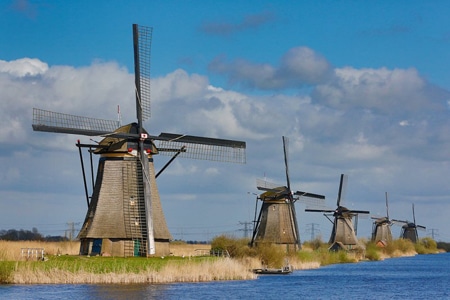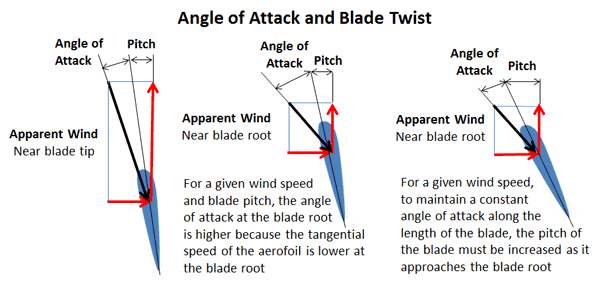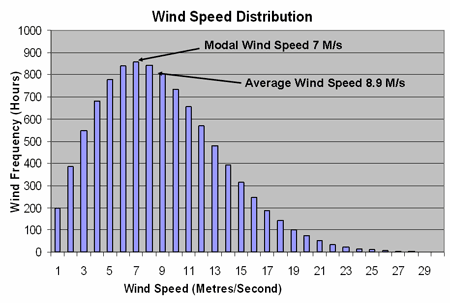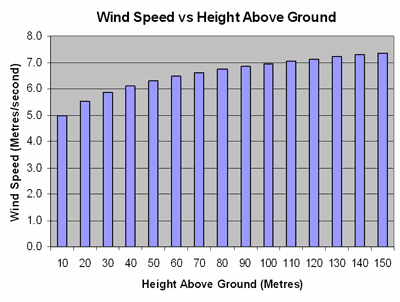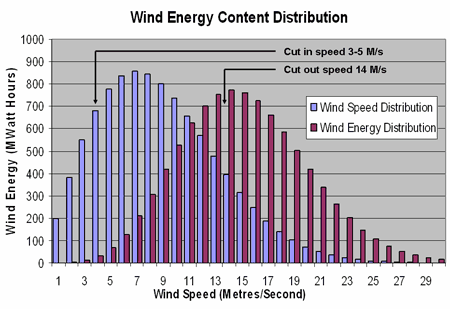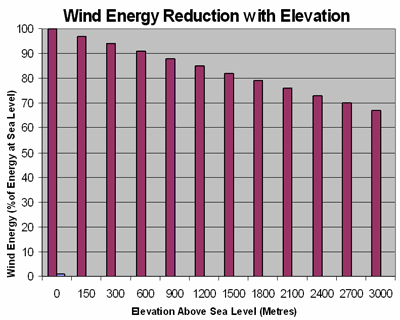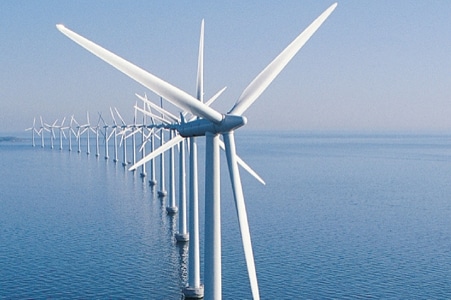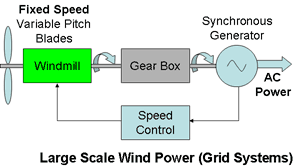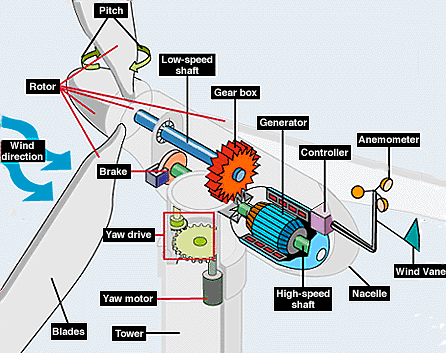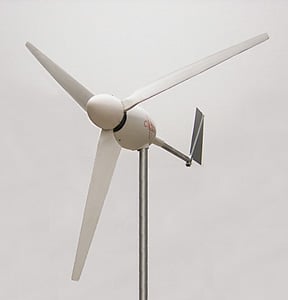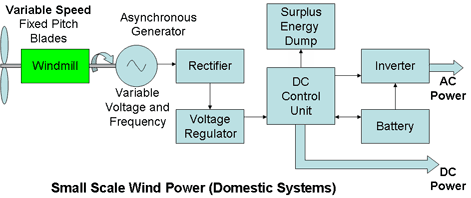Wind Power
The wind is a source of free energy which has been used since ancient
times in windmills for pumping water or grinding flour. The technology
of high power, geared transmissions was developed centuries ago by
windmill designers and the fantail wheel for keeping the main sales
pointing into the wind was one of the world’s first examples of an automatic control system.
Windmills at Kinderdijk in the Netherlands Dating from 1740 Used for Pumping Water from the Polder
Source – Birds As Art
Though modern technology has made
dramatic improvements to the efficiency of windmills which are now
extensively use for electricity generation, they are still dependent on
the vagaries of the weather. Not just on the wind direction but on the
intermittent and unpredictable force of the wind. Too little wind and
they can’t deliver sufficient sustained power to overcome frictional
losses in the system. Too much and they are susceptible to damage.
Between these extremes, cost efficient installations have been developed
to extract energy from the wind.
Available Power From the Wind
-
Theoretical Power
The power P available in the wind impinging on a wind driven generator is given by:
P = ½CAρv3
where C is an efficiency factor known as the Power Coefficient which depends on the machine design, A is the area of the wind front intercepted by the rotor blades (the swept area), ρ is the density of the air (averaging 1.225 Kg/m3 at sea level) and v is the wind velocity.
Note that the power is proportional to area
swept by the blades, the density of the air and to the cube of the wind
speed. Thus doubling the blade length will produce four times the power
and doubling the wind speed will produce eight times the power.
Note also that the effective swept area of
the blades is an annular ring, not a circle, because of the dead space
around the hub of the blades.
A similar equation applies to the theoretical power generated by a “run of river” and “tidal flow” hydro turbines.
Energy Conversion
- Practical Power and Conversion Efficiency
- Blade Design for Optimum Energy Capture
- Design Limits
-
Cut – in Wind Speed This is the
minimum wind velocity below which no useful power output can be produced
from wind turbine, typically between 3 and 4 m/s (10 and 14 km/h, 7 and
9 mph). -
Rated Wind Speed (also associated with the Nameplate Capacity)
This is the lowest wind velocity at which the turbine develops its full
power. This corresponds to the the maximum, safe electrical generating
capacity which the associated electrical generator can handle, in other
words the generator’s rated electrical power output. The rated wind
speed is typically about 15 m/s (54 km/h, 34 mph) which is about double
the expected average speed of the wind. To keep the turbine operating
with wind speeds above the rated wind speed, control systems may be used
to vary the pitch of the turbine blades, reducing the rotation speed of
the rotor and thus limiting the mechanical power applied to the
generator so that the electrical output remains constant. Though the
turbine works with winds speeds right up to the cut-out wind speed, its
efficiency is automatically reduced at speeds above the rated speed so
that it captures less of the available wind energy in order to protect
the generator. While it would be possible to use larger generators to
extract full power from the wind at speeds over the rated wind speed,
this would not normally be economical because of the lower frequency of
occurrence of wind speeds above the rated wind speed. -
Cut – out Wind Speed This is the
maximum safe working wind speed and the speed at which the wind turbine
is designed to be shut down by applying brakes to prevent damage to the
system. In addition to electrical or mechanical brakes, the turbine may
be slowed down by stalling or furling. -
Stalling This is a self correcting or
passive strategy which can be used with fixed speed wind turbines. As
the wind speed increases so does the wind angle of attack until it
reaches its stalling angle at which point the “lift” force turning the
blade is destroyed. However increasing the angle of attack also
increases the effective cross section of the blade face-on to the wind,
and thus the direct wind force and the associated stress on the blades.
A fully stalled turbine blade, when stopped, has the flat side of the
blade facing directly into the wind. -
Furling or Feathering This is a
technique derived from sailing in which the pitch control of the blades
is used to decrease the angle of attack which in turn reduces the “lift”
on the blades as well as the effective cross section of the aerofoil
facing into the wind. A fully furled turbine blade, when stopped, has
the edge of the blade facing into the wind reducing the wind force and
stresses on the blade. -
Survival Wind Speed This is the
maximum wind speed that a given wind turbine is designed to withstand
above which it can not survive. The survival speed of commercial wind
turbines is in the range of 50 m/s (180 km/h, 112 mph) to 72 m/s
(259 km/h, 161 mph). The most common survival speed is 60 m/s
(216 km/h, 134 mph). The safe survival speed depends on local wind
conditions is usually regulated by national safety standards. - Yaw Control
- Capacity Factor
German aerodynamicist Albert Betz showed that a maximum of only 59.3% of the theoretical power can be
extracted from the wind, no matter how good the wind turbine is,
otherwise the wind would stop when it hit the blades. He demonstrated
mathematically that the optimum occurs when the rotor reduces the wind
speed by one third.
In practical designs, inefficiencies in the
design and frictional losses will reduce the power available from the
wind still further. Converting this wind power into electrical power
also incurs losses of up to 10% in the drive train and the generator and
another 10% in the inverter and cabling. Furthermore, when the wind
speed exceeds the rated wind speed, control systems limit the energy
conversion in order to protect the electric generator so that
ultimately, the wind turbine will convert only about 30% to 35% of the
available wind energy into electrical energy.
Note that the power output from commercially
available domestic wind turbines is usually specified at a steady, gust
free, wind speed of 12.5 m/s. (Force 6 on the Beaufort scale
corresponding to a strong breeze). In many locations, particularly
urban installations, the prevailing wind will rarely reach this speed.
Modern, high capacity wind turbines, such as
those used by the electricity utilities in the electricity grid,
typically have blades with a cross section similar to the aerofoils used
to provide the lift in aircraft wings.
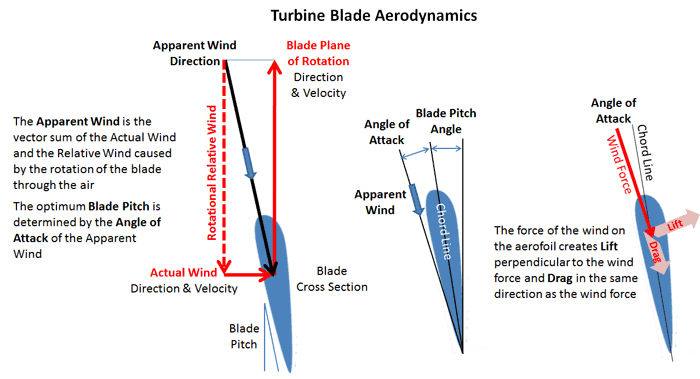 The direction of the apparent wind, that is the incident wind, relative to the chord line of the aerofoil is known as the angle of attack.
The direction of the apparent wind, that is the incident wind, relative to the chord line of the aerofoil is known as the angle of attack.
Just as with aircraft wings, the lift resulting from the incident wind
force increases as the angle of attack increases from 0 to a maximum of
about 15 degrees at which point the smooth laminar flow of the air over
the blade ceases and the air flow over the blade separates from the
aerofoil and becomes turbulent. Above this point the lift force
deteriorates rapidly while drag increases leading to a stall. See more
about the angle of attack.
The tangential velocity S of any blade section at a distance r from the centre of rotation (the root of the blade) is given by S = r Ω where Ω is the angular velocity of rotation in radians.
For a given wind speed the apparent wind will
be different at the root of the blade from the apparent wind at the tip
of the blade because the rotational relative wind speed is different.
For a given speed of rotation,
the tangential velocity of sections of the blade increases along the
length of the blade towards the tip, so that the pitch of the blade must
be twisted to maintain the same, optimum angle of attack at all
sections along the length of the blade. The blade twist is thus
optimised for a given wind speed. As the wind speed changes however, the
twist will no longer be optimum. To retain the optimum angle of attack
as wind speed increases a fixed pitch blade must increase its
rotational speed accordingly, otherwise, for fixed speed rotors,
variable pitch blades must be used.
The number of blades in the turbine rotor and its rotational speed must be optimised to extract the maximum energy from the available wind.
While using rotors with multiple blades
should capture more wind energy, there is a practical limit to the
number of blades which can be used because each blade of a spinning
rotor leaves turbulence in its wake and this reduces the amount of
energy which the following blade can extract from the wind. This same
turbulence effect also limits the possible rotor speeds because a high
speed rotor does not provide enough time for the air flow to settle
after the passage of a blade before the next blade comes along.
There is also a lower limit to both the
number of blades and the rotor speed. With too few rotor blades, or a
slow turning rotor, most of the wind will pass undisturbed through the
gap between the blades reducing the potential for capturing the wind
energy. The fewer the number of blades, the faster the wind turbine
rotor needs to turn to extract maximum power from the wind.
The notion of the Tip Speed Ratio (TSR) is a concept used by wind turbine designers to optimise a blade set to
the shaft speed required by a particular electricity generator while
extracting the maximum energy from the wind.
The tip speed ratio is given by:
TSR=ΩR/V
where Ω is the angular velocity of the rotor, R is the distance between the axis of rotation and the tip of the blade, and V is the wind speed.
A well designed typical three-bladed rotor would have a tip speed ratio of around 6 to 7.
For safety and efficiency reasons wind
turbines are subject to operating limits depending on the wind
conditions and the system design.
The cut-out speed is specified to be as high
possible consistent with safety requirements and practicality in order
to capture as much as possible of the available wind energy over the
full spectrum of expected wind speeds (See diagram of Wind Speed Distribution below). A cut-out speed of 25 m/s (90 km/h, 56 mph) is typical for very large turbines.
Windmills can only extract the maximum power from the
available wind when the plane of rotation of the blades is perpendicular
to the direction of the wind. To ensure this the rotor mount must be
free to rotate on its vertical axis and the installation must include
some form of yaw control to turn the rotor into the wind.
For small, lightweight installations this is normally
accomplished by adding a tail fin behind the rotor in line with its
axis. Any lateral component of the wind will tend to push the side of
the tail fin causing the rotor mount to turn until the fin is in line
with the wind. When the rotor is facing into the wind there will be no
lateral force on the fin and the rotor will remain in position. Friction
and inertia will tend to hold it in position so that it does not follow
small disturbances.
Large turbine installations have automatic control systems
with wind sensors to monitor the direction of the wind and a powered
mechanism to drive the rotor into its optimum position.
Electrical generating equipment is usually
specified at its rated capacity. This is normally the maximum power or
energy output which can be generated in optimal conditions. Since a wind
turbine rarely works at its optimal capacity the actual energy output
over a year will be much less than its rated capacity. Furthermore there
will often be periods when the wind turbine can not deliver any power
at all. These occur when there is insufficient wind to power the turbine
system, or other periods, fortunately only a few, when the wind turbine
must be shut down because the wind speed is dangerously high and
exceeds the system cut-out speed.
The capacity factor is simply the wind
turbine generator’s actual energy output for a given period divided by
the theoretical energy output if the machine had operated at its rated
power output for the same period. Typical capacity factors for wind
turbines range from 0.25 to 0.30. Thus a wind turbine rated at 1
MegaWatt will deliver on average only about 250 kiloWatts of power. (For
comparison, the capacity factor of thermal power generation is between 0.70 and 0.90)
Wind Supply Characteristics
- Wind speed
- Wind Consistency
- Wind Speed Distribution
-
The modal wind speed, that is the the
speed at which the wind most frequently blows, is less than the average
wind speed which is the speed often quoted as representing the typical
wind conditions. For reference, the average wind speed across the UK
quoted by the Department of Trade and Industry (DTI), is approximately
5.6 metres per second [m/s] at 10 metres above ground level (agl).” -
Published average wind speeds are only
reliable for open rural environments. Wind speeds just above roof level
in urban environments will be considerably less than the quoted averages
because of turbulence and shielding caused by buildings and trees. A
wind turbine sited below the ridge of a building or at a similar height
in the garden of an urban dwelling as often shown in the product sales
literature is unlikely to provide the energy levels claimed in the
specifications. - The distribution does not represent the energy content of the wind since this is proportional to the cube of the wind speed.
-
A distribution such as the one above is
only valid for the prevailing wind conditions at a particular height
above the ground. Average wind speeds usually tend to increase with
height then level off which is why wind turbines are usually installed
as high above ground as possible. - Wind Energy Distribution
-
The peak wind energy occurs at wind speeds
considerably above both the modal and average wind speeds since the
wind energy content is proportional to the cube of its speed. -
Very little energy is available at low
speeds and most of this will be needed to overcome frictional losses in
the wind turbine. Energy generation typically does not cut in until wind
is blowing at speeds of at least 3 m/s to 5 m/s. -
High wind speeds cause high rotation
speeds and high stresses in the wind turbine which can can result in
serious damage to the installation. To avoid these dangerous conditions,
wind turbines are usually designed to cut out at wind speeds of around
25 m/s either by braking or feathering the rotor blades allowing the
wind to spill over the blades, though smaller domestic installations may
have lower operating limits. -
Because of the limitations of the
generating system and also upper speed limit at which the wind turbine
can safely be used, it may capture only half or less of the available
wind energy. -
For a given wind speed the wind energy
density decreases with increases in altitude. However at the same time
the actual wind speeds tend to increase with height above ground level.
Since the wind energy is proportional to the cube of the wind speed, the
net effect is that wind energy tends to increase with the height above
ground level.
Though the force and power of the wind are
difficult to quantify, various scales and descriptions have been used to
characterise its intensity. The Beaufort scale is one measure in common
use. The lowest point or zero on the Beaufort scale corresponds to the
calmest conditions when the wind speed is zero and smoke rises
vertically. The highest point is defined as force 12 when the wind speed
is greater than 34 metres per second (122 km/h, 76 mph). as occurs in
tropical cyclones when the countryside is devastated by hurricane
conditions.
Small wind turbines generally operate between
force 3 and force 7 on the Beaufort scale with the rated capacity
commonly being defined at force 6 with a wind speed of 12 m/s.
Below force 3 the wind turbine will not generate significant power.
At force 3, wind speeds range from 3.6 to
5.8 m/s (8 to 13 mph). Wind conditions are described as “light” and
leaves are in movement and flags begin to extend.
At force 7, wind speeds range from 14 to 17
m/s (32 to 39 mph). Wind conditions are described as “strong” and whole
trees are in motion.
With winds above force 7 small, domestic wind turbines should be shut down to prevent damage.
Large turbines used in the electricity grid
are designed to work with wind speeds of up to 25 m/s (90 km/h, 56 mph)
which corresponds to between force 9 (severe gale, 23 m/s) and force 10
(storm, 27 m/s) on the Beaufort Scale.
Wind power has the advantage that it is
normally available 24 hours per day, unlike solar power which is only
available during daylight hours. Unfortunately the availability of wind
energy is less predictable than solar energy. At least we know that the
sun rises and sets every day. Nevertheless, based on data collected over
many years, some predictions about the frequency of the wind at various
speeds, if not the timing, are possible.
Care should be taken in calculating the
amount of energy available from the wind as it is quite common to
overestimate its potential. You can not simply take the average of the wind speeds throughout the year and use it to calculate the
energy available from the wind because its speed is constantly changing
and its power is proportional to the cube of the wind speed. (Energy =
Power X Time). You have to weigh the probability of each wind speed with
the corresponding amount of energy it carries.
Experience shows that for a given height
above ground, the frequency at which the wind blows with any particular
speed follows a Rayleigh Distribution. An example is shown below.
Important Notes
An empirical formula developed by D.L. Elliott of Pacific Northwest Labs gives the wind speed V at a height H above ground level as
V = Vref ( H / Href )α
Where Vref is the reference wind speed at a reference height Href and the exponent α is a correction factor dependent on obstacles on the ground, the
density of the air and wind stability factors. In wind resource
assessments α is commonly assumed to be a constant 1/7th . The histogram below shows this relationship.
The histogram below shows the resulting distribution of the
wind energy content superimposed on the the Rayleigh wind speed
distribution (above) which caused it. Unfortunately not all of this wind
energy can be captured by conventional wind turbines.
Notes
For a given wind speed the wind
energy also depends on the elevation of the wind turbine above sea
level. This is because the density of the air decreases with altitude
and the wind energy is proportional to the air density. This effect is
shown in the following histogram.
Notes
-
As the density of air decreases with
altitude, the wind energy density also decreases. By contrast the
available solar energy increases with altitude due to lower atmospheric
absorption. See Solar Radiation and Insolation (Incident Solar Radiation).
- Location Considerations
Generally marine locations and exposed hilltops provide the most
favourable wind conditions with wind speeds consistently greater than 5
m/s.
Turbulent conditions will reduce the amount of energy which can be
extracted from the wind reducing in turn the overall efficiency of the
system. This is more likely to be the case over land than over the sea.
Raising the height of the turbine above the ground effectively lifts it
above the worst of the turbulence and improves efficiency.
Domestic wind turbines located between buildings in urban
environments rarely operate at peak efficiency suffering from turbulence
as well as being shielded from the wind by buildings and trees.
Practical Systems
Community/Grid Installations
Vesta 7 MW Wind Turbines with a Rotor Diameters of 164 m
(Source The IET)
Large scale wind turbine generators with
outputs of up to 8 MWe or more with rotor diameters up to164 metres are
now functioning in many regions of the world with even larger designs in
the pipeline..
A typical system employs a fixed speed rotor
with three variable pitch blades which are controlled automatically to
maintain a fixed rotation speed for any wind speed. The rotor drives a
synchronous generator through a gear box and the whole assembly is
housed in a nacelle on top of a substantial tower with massive
foundations requiring hundreds of cubic metres of reinforced concrete.
Source US DOE (EERE)
Large rotor blades are necessary to intercept
the maximum air stream but these give rise to very high tip speeds. The
tip speeds however must be limited, mainly because of unacceptable noise
levels, resulting in very low rotation speeds which may be as low as 10
to 20 rpm for large wind turbines. The operating speed of the generator
is however is much higher, typically 1200 rpm, determined by the number
of its magnetic pole pairs and the frequency of the grid electrical
supply. Consequently a gearbox must be used to increase the shaft speed
to drive the generator at its synchronous speed.
Grid connected systems are dimensioned for
average wind speeds 5.5 m/s on land and 6.5 m/s offshore where wind
turbulence is less and wind speeds are higher. While offshore plants
benefit from higher sustainable wind speeds, their construction and
maintenance costs are higher.
Wind Farms
Grouping 10 to 100 wind turbines together in so
called “wind farms” can lead to savings of 10% to 20% in construction,
distribution and maintenance costs.
According to NREL the”footprint” of land
needed to provide space for turbine towers, roads, and support
structures is typically between 0.1 and 0.2 hectares (0.25 and 0.50
acres) per turbine. With the typical capacity of wind turbines installed
in existing wind farms being around 2 MW, it would take a wind farm
with 2000 wind turbines covering 200 to 400 hectares (500 to 1000
acres) just to replace the 4000 MWe power generated by the UK’s Drax coal fired power station.
Unfortunately for the economics of wind
turbines, the utility company needs to keep the equivalent capacity from
other sources (conventional generating stations or batteries) just to
keep the grid customers supplied when the wind is not blowing.
Domestic Wind Turbine Installations
1.6 kW Wind Turbine with 2.8 Metre Diameter Rotor by Cyclone Green Power Inc.
In a typical domestic system the wind turbine is coupled directly to a three phase asynchronous permanent magnet AC generator mounted on the same shaft. To save on capital costs, domestic
installations do not have variable pitch rotor blades so the rotor speed
varies with the wind speed. The generator output voltage and frequency
are proportional to the rotor speed and the current is proportional to
the torque on the shaft. The output is rectified and fed through a buck-boost regulator to an inverter which generates the required fixed amplitude and frequency AC voltage.
Note: There is possible confusion in the
classification of the generator. It is actually a synchronous generator
because the frequency of its output is directly synchronised with the
rotor speed. In this application however it is called an asynchronous
generator because the output frequency of the generator is not
synchronised with the mains/utility frequency.
- Urban Installations
- Economics
- Carbon Footprints
- Rural Installations
- Hybrid Installations
Wind turbine blade sizes in urban
applications are usually limited for practical reasons to less than
about 1 metre (2 metres diameter) as well as by local planning
ordinances and for similar reasons the height of the turbine above
ground is limited to just above rooftop level but below treetop level.
A typical domestic installation with a 1.75m swept diameter, (swept area of 2.4m2),
costs around £1500 ($2250). At the rated wind speed of 12.5m/s (28 mph)
the wind power intercepted will be 2870 Watts, but after taking into
account all the unavoidable system losses, the actual electrical output
power will be around 1000 Watts. However this is at the upper end of the
performance possibilities. Wind turbulence and shielding due to
buildings and trees inhibits sustained strong, gust free wind flow and
in any case, for most of the time, the wind speed will more likely be
towards the lower end of the performance specification at 4 m/s (9 mph),
that is a light breeze. At this speed the power output of the system
will be about 32 Watts – Not enough to power a single light bulb. For
much of the time the power generated could be less than the quiescent
power drain of the inverter.
Running with a constant power output of 32
Watts for a full year would generate only 280 kWh (280 Units) of
electrical energy worth £28 at today’s price of £0.10 ($0.15) per kWh.
To put it into perspective, a typical UK household consumes about 5,000
kWh of electrical energy per year.
Because the system is connected directly to
the grid there is no need for battery back-up and in any case the cost
of the batteries would make an already weak economic case for the system
even weaker. See also Grid Connected Systems
Thus small domestic rooftop wind turbine installations do not make a serious contribution to the household energy supply.
Self sufficiency and selling surplus energy
back to the utility are out of the question and the payback period on
the capital investment is out of sight.
As with solar power, if the investment fails the conventional economic tests, the notion of carbon footprints is often used to justify the expense, based on the potential for
reducing the amount of greenhouse gases emitted by alternative methods
of power generation.
The economics of rural and remote locations
make wind power more attractive than for urban locations. Because of
the remoteness, connection to the electricity grid may be impossible or
prohibitively expensive. Furthermore, larger, more efficient wind power
installations are possible and the prevailing winds will also be higher.
See also Stand Alone Systems
Hybrid systems combining wind and solar power
provide energy diversity reducing the risk of power outages. Wind
speeds are often high in the winter when the available solar energy is
low and low in the summer when the available solar energy is high.
Hybrid systems are discussed in more detail in the section on Remote Area Power Systems
Wind power provides a valuable complement to
large scale base load power stations. Where there is an economic
back-up, such as hydro power or large scale storage batteries, which can
be called upon at very short notice, a significant proportion of
electricity can be provided from wind.


